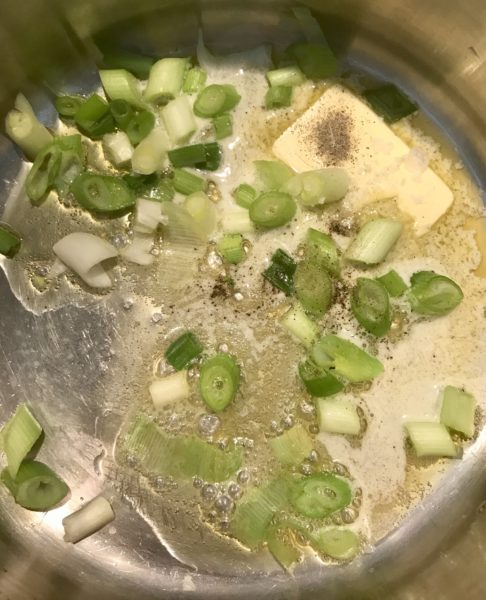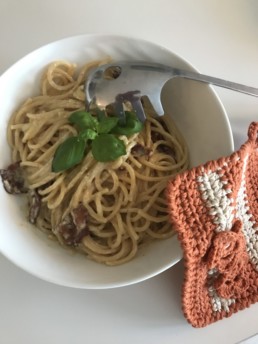What’s for Supper – Nettle soup with poached egg
Next time you go for your daily walk, bring gloves and a bag and go in search of young nettles. Given how rampant they are, it shouldn’t be very difficult. These vitamin bombs, packed with vitamin A and C, as well as iron and other minerals, have been used for medicinal purposes through the ages. Nettle soup was a seasonal thing on our table when I grew up, but how many people make it these days? I was given a bag of tender nettles by my next door neighbour as she returned from her last day of freedom, having received the letter to tell her she is one of 1.5 million who have to completely isolate. Such a kind gift and also a reminder that now we have more time on our hands, we should be more mindful of the nature on our door step. Enjoying birdsong, the magenta pink inside daisies spread across meadows, the warmth of the sun on our face. Nettles, like spinach, have an affinity with eggs and share the earthy flavours of spinach. The nettle soups of my childhood were served with half a soft boiled egg in the bowl. I prefer a less frugal poached egg. If you are a vegan, this soup has plenty of flavour as it is, sans egg.

Recipe for 2
1 litre tender nettles, washed and patted completely dry
4-5 spring onions
A knob of butter and/or a little sunflower oil
1 tablespoon plain flour (gluten free if you like)
500ml vegetable stock
100 ml cream or a large dollop of Crème Fraiche (dairy free if you like)
2 eggs
1/2 teaspoon white wine vinegar
Sea salt and ground black pepper
Tender nettles don’t have much stinging power, and as soon as they are cooked, they loose their sting entirely. If you are worried about getting the odd sting while preparing the nettles, use scissors rather than a knife to roughly cut the nettles. Slice the spring onions.


Heat butter and oil in a saucepan, add the nettles and the spring onion, season with a good pinch of salt and cook over a medium heat for 2-3 minutes. You will find that you need to add a bit of water to prevent the nettles from sticking to the pan and a bit more again to blend the nettles and onion. Use a stick blender or transfer the nettles into a blender, food processor or NutriBullet and blitz.

Return to the saucepan, sprinkle over the flour and gradully, while stirring to avoid lumps, add the stock. Allow to simmer for a few minutes. You could enjoy the soup like this, but it will taste even more delicious if you add a little cream or Crème Fraiche.
Check the seasoning – I used my usual hob-side trio of sea salt, caster sugar and black pepper. My grandmother Greta taught me how transformative a pinch of sugar can be. I also find Marsala to have the same transformative powers. The Sicilian sweet, raisiny wine improves the flavour of just about everything, in particular soups but also, I would say, the mood of the chef.

Perfect poached eggs
The knack of poaching a perfect egg comes naturally to some, while others never get the hang of it. However, success is not down to luck or chance. Follow these rules and you will produce decent, possibly even perfect, poached eggs. Firstly, the fresher the egg, the more elastic the egg white and therefore the more easily it will set in a tidy fashion. Secondly, poaching means cooking in barely moving water. It is not the same as boiling, which will result in rubbery eggs. Thirdly, drop the eggs in close to the surface of the simmering water. And lastly, add something acidic, for instance white wine vinegar or lemon juice, to the water as it will help to set the egg white.
The pan should leave plenty of space for the egg/s. I much prefer using a wide, open pan like a sauté pan to using a deep saucepan. Fill with water, add half a cap full (as in the cap on the vinegar bottle or roughly 1 small teaspoon) of white wine vinegar or a little lemon juice and bring to a rolling boil. As you do so, crack the eggs into glasses or ramekins. When the water reaches rolling boil, place the edge of the glass or ramekin as close to the surface of the water as you can and gently but swiftly allow the egg to slide into the water. As soon as this is done, turn the heat down to low. Watch the water. Bubbles should appear sporadically. Leave the egg for 3 minutes. Do not worry if the white has spread out – you will be pleasantly surprised at how neat your egg will look once you have fished it out and, if needed, trimmed the edges a little. Be gentle when you lift out the egg and place it on double folded kitchen paper.
The enrobed yolk should, when gently prodded, feel very soft to the touch while the white should be set. There is simply no point in choosing poaching as your cooking method if you don’t like soft yolks. If a firmer yolk is what you desire, you might as well boil your egg.
Have fun in the kitchen – cook with your children and let them loose on gadgets. Just make sure that lids are firmly on and that hands are kept away from any moving parts.
Join me again tomorrow
As usual, no sooner have I finished one meal than I ask myself what I might like for supper tomorrow. I think something from my native Sweden, involving potatoes, eggs, milk, a smidgeon of smoked salmon (2 weeks ago I cut a large pack of smoked salmon straight through the plastic into smaller pieces which made it easer to find space for it in the jam packed freezer). And of course, what kind of Swede would I be if I didn’t also have lots of dill in my freezer. And for the weekend, I will be showing you how to make bread!
What’s for Supper – Classic Carbonara
March 31, 2020
A Food Safari for 150 at Churchill college
July 17, 2015

